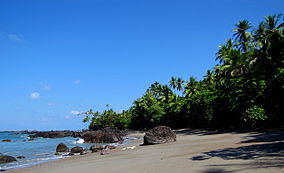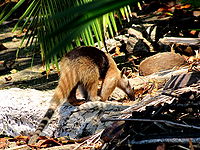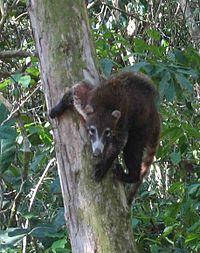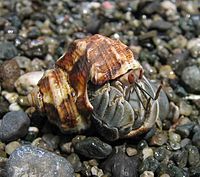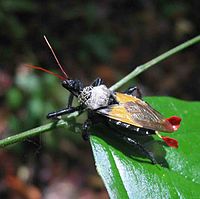- Corcovado National Park
-
For the park in Chile, see Corcovado National Park (Chile).
Corcovado National Park IUCN Category II (National Park)
Corcovado National ParkLocation Osa Peninsula, Costa Rica Coordinates 8°33′0″N 83°35′0″W / 8.55°N 83.583333°WCoordinates: 8°33′0″N 83°35′0″W / 8.55°N 83.583333°W Area 425 km² Established October 24, 1975 Governing body National System of Conservation Areas (SINAC) Corcovado National Park (Spanish: Parque Nacional Corcovado) is a National Park on the Osa Peninsula in the South West of Costa Rica (9° North, 83° West), which is part of the Osa Conservation Area. It was established on 24 October 1975, and encompasses an area of 425 km² (263 mi²). It is widely considered the crown jewel in the extensive system of national parks and biological reserves spread across the country. The ecological variety is quite stunning. National Geographic has called it "the most biologically intense place on Earth". Not only is the park very popular with tropical ecologists, a visitor can expect to see an abundance of wildlife. One should come well prepared though (see below).
Contents
Flora and fauna
The park conserves the largest primary forest on the American Pacific coastline and one of the few remaining sizeable areas of lowland tropical rainforests in the world. Logging usually takes place in lowland areas because those areas are more accessible and contain the largest and most economically valuable trees. But those habitats are also usually the richest in biodiversity. So even though still approximately half the tropical rainforests on Earth remain, what is left of the originally rich lowland tropical rainforests is usually too small to support the original natural biodiversity. Larger animals, especially, need a large habitat free of human activity. Unfortunately this means that even tourism, the economic incentive for Costa Rica and other developing nations to preserve and protect parks such as Corcovado, actually threatens the long-term biodiversity of the park.
Tamandua anteater
Corcovado is home to a sizable population of the endangered Baird's Tapir and even a small population of the very rare Harpy Eagle. The park's rivers and lagoons are home to large populations of both the American crocodile and Spectacled Caiman, along with Bull sharks. Corcovado is also one of the final strongholds of the Jaguar within Central America and several other felines are also present, including Ocelot, Margay, Jaguarundi, and Puma. All four Costa Rican monkey species can be seen within the park, including the endangered Central American Squirrel Monkey, White-faced Capuchin, Mantled Howler, and Geoffroy's Spider Monkey. Other mammals present include Two-toed and Three-toed Sloth, Collared Peccary, Northern Tamandua and Silky Anteater. Poison dart frogs and several species of snake (including the venomous Fer-de-Lance and Bushmaster) are also common within the park.
The abundance in wildlife can in part be explained by the variety of vegetation types, at least 13, including montane forest (more than half the park), cloud forest, jolillo forest (palm swamp), prairie forest, alluvial plains forest, swamp forest, freshwater herbaceous swamp and mangrove, together holding over 500 tree species, including purple heart (tree), poponjoche, nargusta, banak (tree), cow tree, espave and crabwood (tree). Another reason for the diversity (as with all of Costa Rica) is that it lies on a north-south corridor for flora and fauna; part of the "land bridge" and wildlife corridor that links the large continents of North America and South America.
Visiting
As when visiting any sensitive natural area, please be sure to clean all of your hiking and/or camping gear (in particular shoe/boot soles and tents) prior to visiting to decrease the chance introducing non-native seeds.
Corcovado National Park is open to the public and can be visited on day trips and for overnight visits. As of January 2009, admission is $10 per person per day for non-Costa Rican residents. Reservations for overnight visits in the park can be made in Puerto Jiménez on the east coast of the peninsula. One may camp or stay indoors at one of several ranger stations equipped with bunks. If one wants basic meals served, reservations should be made about a week in advance. Take note that researchers get preference over other visitors (though there is usually enough room for self-catering campers).
One can make day visits into the park from several lodging options on both the north and south entrances to the park, as well as through organised excursions that fly into the park. One can get to the Corcovado National Park via Puerto Jimenez or Drake Bay. These two towns serve as the main entry points to the park. There are two tracks, one coastal and one inland, and four ranger stations in the park where one can stay overnight; three at the park entrances and one at the intersection of the two tracks. One track runs Northwest to Southeast along the coast to Estacion La Leona, with the Estación Sirena roughly in the middle. The second track runs inland from Estacion Sirena to Estación Los Patos at the Eastern end of the park. One can fly into the park (via chartered aircraft) to Estación Sirena, from where one can follow relatively short loop-trails. Carate (near Estacion La Leona), also has an airstrip and road access from Puerto Jimenez. To walk through the park one needs a reasonable fitness, at least two or three days, good planning and caution. During the wet months (July to November) parts of the park may be closed.
On the coastal track there are several rivers need to be forded. These rivers can all be very dangerous if forded at high tide or if one is inexperienced in this kind of an environment. Rio Sirena is commonly regarded as the most dangerous of crossings, primarily because it flows directly into the massive Laguna Corcovado in the isolated heart of the park. Bull sharks are so common within the river that during high tide they are almost always visible and are probably the only animal within Corcovado (besides the rare 4-meter-plus crocodile) that represents a very serious danger to humans. It is said that, since the Rio Sirena flows into such a large and rich food source as Laguna Corcovado, that the crocodiles living within this river are much larger (some over 5 meters) than those found in the other rivers in Corcovado. However, at low tide this crossing is essentially no less hazardous as any of the other river crossings. The Rio Claro, which is approximately 40 minutes south of Rio Sirena, is said to be safer, although both appear to the naked eye as very similar in size. American crocodiles will also most certainly be seen basking and floating near the mouth of the Rio Claro. It is generally accepted that Bull Sharks are not present within Rio Claro, although this is not confirmed nor is it entirely accepted by some of the local guides. Spectacled Caiman are also present within all rivers and lagoons, but are very small, timid and completely harmless to humans. Despite the presence of these predators, by far the greatest risk you will face while crossing any river is the strong current. Upstream Rio Claro is a popular night swimming spot amongst guides and their groups, therefore it is doubtful that attacks by crocodiles or sharks in this river are a concern. Bull sharks, although of relatively modest size, are well known for their extremely aggressive and unpredictable behavior, therefore crossing the Rio Sirena at high tide is simply not an option and nearly suicidal. The elusive Jaguar is a large, beautiful and potentially intimidating feline but is generally regarded as shy and harmless. They are capable of taking down prey as large as Tapir but appear to be reclusive and uninterested in human activity.
Most animal sightings can be expected on the coastal track, with scarlet macaws (the largest population in the country) flying overhead, hermit crabs on the beach, pelicans fishing in the sea and, on the sections that go slightly inland, spider monkeys (take care not to get urinated on when they are in a tree overhead), tamandua anteaters, pumas, white faced capuchin monkeys, lineated woodpeckers and coatis (to name just a few). With luck one might even spot a tapir, even though they're nocturnal. Corcovado is also a good place to spot the red-eyed tree frog, as well as the glass frog with its transparent skin, and the enamel-bright poison-arrow frogs. From Estación Sirena one can follow many short tracks, on which one can also take short night-strolls into the forest with a good chance of running into a tapir. They're impressive to see but harmless if left in peace. Jaguars are present and some individuals frequent the beach near Madrigal at night. You are very likely to see their tracks, sometimes very fresh and frequent, but very unlikely to see the actual cat. The most common animal in the park is by far the White-nosed Coati, which one can expect to encounter dozens of times on the beach hike between La Leona and Sirena, digging for and feeding on the abundant Moon Crabs.
The inland track to Estación Los Patos goes through secondary growth for much of the way, but it is still a beautiful walk with a little more variation and it's easier walking with no sand and no sizeable river crossings.
Other animals in the park include Central American Squirrel Monkeys, mantled howler monkeys, both two-toed and three-toed sloths, agoutis, giant anteaters, Great Curassows, black hawks, Spectacled Owls, hummingbirds, 220 species of butterflies, golden orb spiders (who build huge webs), otters and raccoons. Four species of sea turtle (green, Pacific Ridley, Hawksbill, and Leatherback) nest on the beaches.
Creation and threats
Because of the remoteness of the peninsula, logging started only in the 1960s. By 1975 there were plans for a major international logging operation. Researchers petitioned President Daniel Oduber to protect the area, which he did by making it a National Park. For this he received the Albert Schweitzer Award from the Animal Welfare Institute. The already present goldminers were allowed to stay. By 1986 their number had increased to about 1,000 (not counting their families), who also hunted the wildlife. It was decided to evict them. There is, however, still some illegal mining going on (using more destructive modern mining methods). Illegal logging is not frequent, but the trees that are removed are scarce and essential to the ecosystem.
Increased tourism has led to an increased presence of humans in the park, which may threaten the long-term survival of the park's larger mammals. To help combat the threat of over-exposure, many agencies and other groups (including Conservation International, The Nature Conservancy, WWF–U.S., rain-forest conservation groups in several countries, Catholic Relief Service, Organization of American States, and the Costa Rican, Danish, Dutch, Swedish and U.S. governments) have come together to provide aid to the conservation cause.
External links
- practical information for visitors
- extensive background information
- Corcovado National Park at Costa Rica National Parks
- GringoGuideTravel: Maps and detailed descriptions of the trails in Corcovado.
National Parks of Costa Rica (by Conservation Area) Arenal Huetar Norte Arenal Tilaran Caribbean La Amistad Central Pacific Central Volcanic Guanacaste Osa Corcovado · Piedras BlancasPacific La Amistad Tempisque Tortuguero Cocos Island Categories:- IUCN Category II
- National parks of Costa Rica
- Protected areas established in 1975
- Puntarenas Province
Wikimedia Foundation. 2010.

